Firsthand: Community is a new series by Mothership, where we explore the spirit of community in Singapore through in-depth articles and videos.
From Tampines to Tuas, we’ll investigate the untold stories of the different neighbourhoods in Singapore — firsthand.

Every weekend at Marina East Park, dozens of colourful parrots take to the skies in raucous free flight.


Their owners, ranging from schoolchildren to seniors, emphatically call out for their parrots to return, and incredibly, the feathered creatures did so on command, each guided by their owner's hand gestures and voice.
It was a sight to behold, and felt akin to a paid-for performance one might see at a zoo or a circus show.
Except that these are not showbirds reared to perform, nor are their trainers professional animal handlers.
Rather, what you'll encounter at the far end of Marina East Drive is a group of bird enthusiasts and their pet birds.
The group gathers each weekend to practice what is known as "free flying" — where the birds are allowed to fly in an open space, free from their usual restraints.
They're now 100 members strong, but when Wings of Parrot Community (WOPC) first started in 2017, it was just Desmond Lim, 52, and his family.
 From left to right: Lim's daughter, his wife, and Lim himself.
From left to right: Lim's daughter, his wife, and Lim himself.
Over the years, the group has grown from the family of three to the huge community it is today.
When we arrived on a Saturday afternoon, more than two dozen members had already gathered, dressed in matching blue shirts.
Members came prepared with their own equipment – colourful bird stands embellished with their parrots' names, parrot carriers, camping chairs.
This transformed an empty field into a parrot playground, and a gentle buzz of conversation between bird owners filled the air, occasionally punctuated by the sound of parrots chirping or squawking.
Some of them brought cold drinks to beat the heat, and one casually cracked open a beer while enjoying the bustle around him.

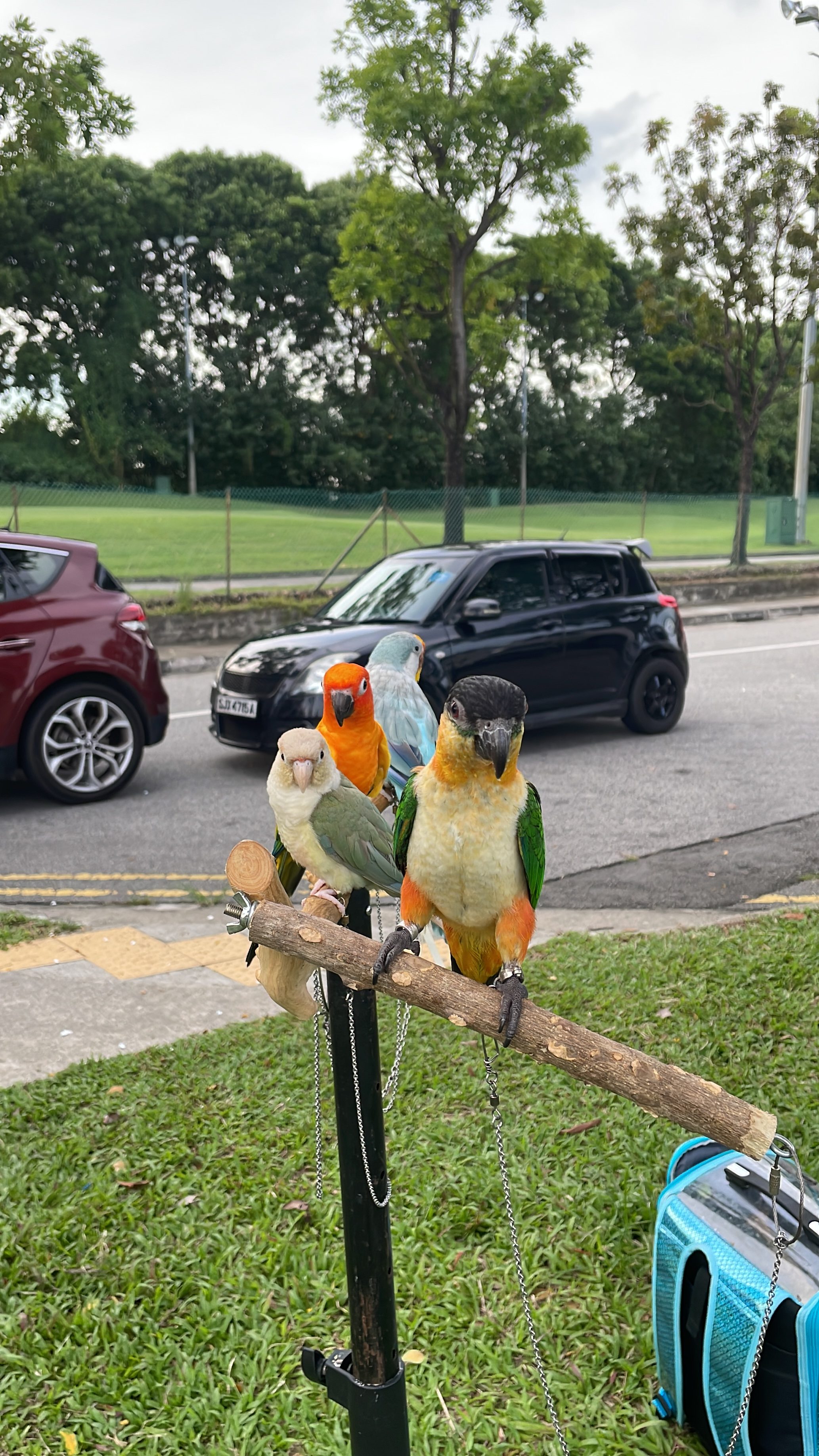 Some of the parrots were chained to their bird stand, in order to prevent them from flying off if accidentally frightened.
Some of the parrots were chained to their bird stand, in order to prevent them from flying off if accidentally frightened.
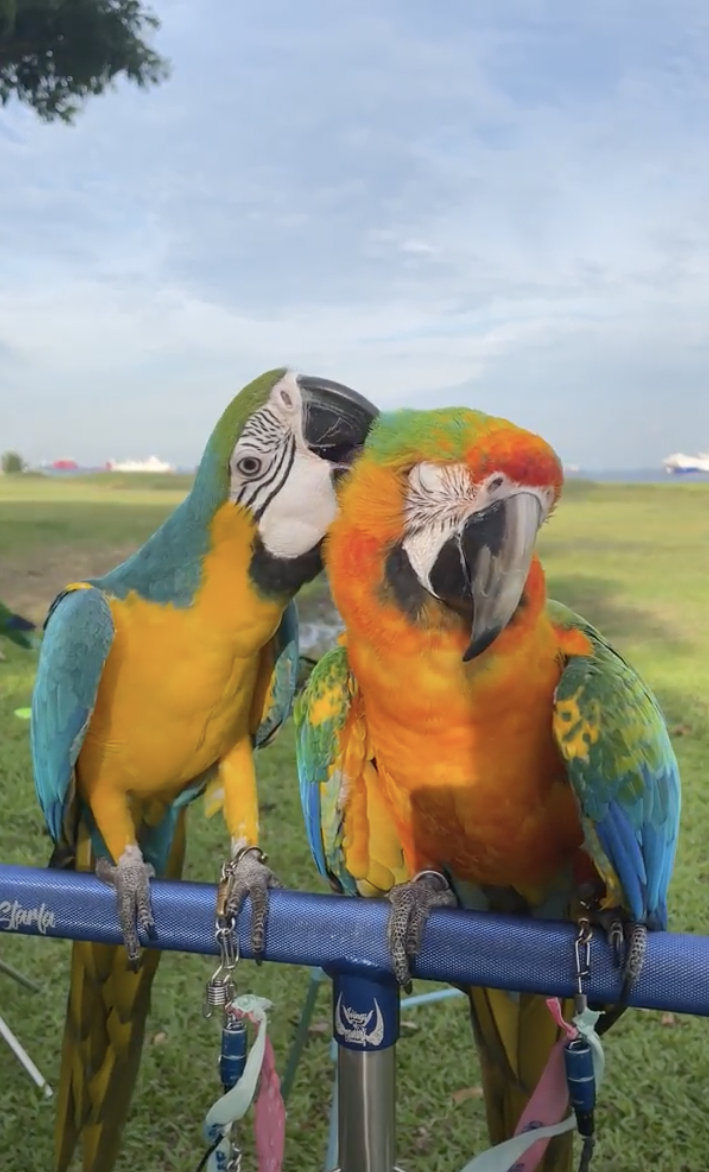 The larger parrots also had GPS trackers attached to them.
The larger parrots also had GPS trackers attached to them.
The scene was striking, with many things happening at once – some members were teaching their parrots tricks, while others were launching their parrots to free fly across the field.
Passersby stopped to stare, and every now and then, a curious onlooker would approach the members to ask what was going on.
“People are like, wow this is amazing, something new,” shared Joanne Khoo, one of WOPC's longtime members.
“There’s been many children who are [initially] scared of the parrots, but [they] really take to them.
There have also been people who come back every weekend to check us out. They’ll bring their food and just sit there and picnic.”
Singapore’s first bird academy
Lim explained that he had always wanted to get a parrot of his own, having been inspired as a child by the sight of parrots free flying at Jurong Bird Park.
When his daughter told him that she had wanted a pet parrot as well, it had thus felt like the right time to finally get one.
The family thus welcomed their first of many birds to come — a Sun Conure named Sunset.
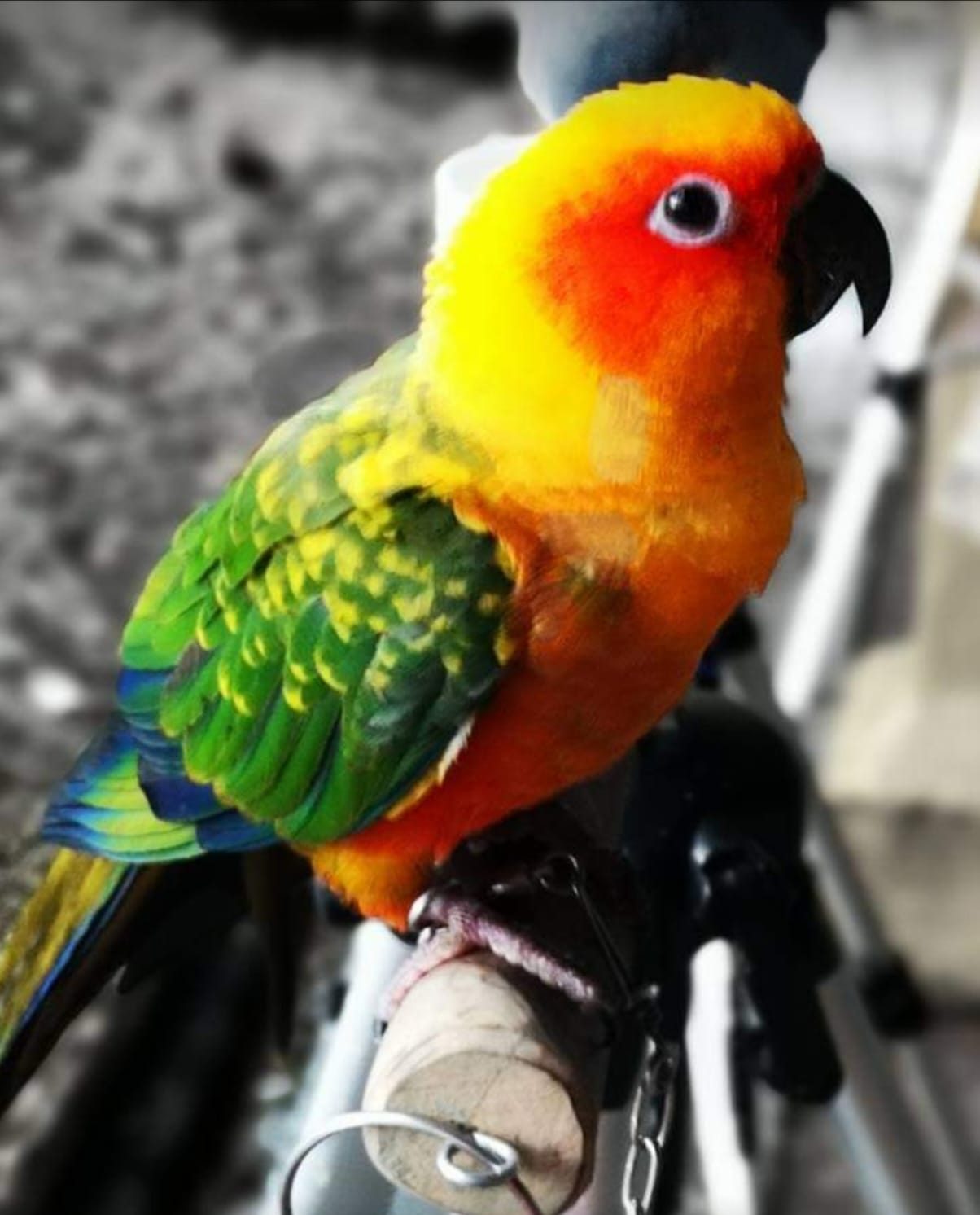 Sunset. Image via Lim
Sunset. Image via Lim
The family subsequently learnt to train their first parrot at home, guided by the shopowner who sold them their parrot.
According to Lim, the shopowner was also a “very well known” bird trainer who taught parrots tricks for performances in malls and at events.
It was through this trainer that Lim learnt how to read the body language of parrots and better understand these intelligent creatures.
Hooked, Lim soon bought more parrots for the family, including two more Conure parrots, as well as two Macaws.
 Lim with some of his parrots, Happy, Rio, Angel, and Skylar, during a weekend free flight session.
Lim with some of his parrots, Happy, Rio, Angel, and Skylar, during a weekend free flight session.
Conures are small to medium-sized parrots native to South America, and typically have a lifespan of 20 to 30 years, while Macaws are larger-sized members of the parrot family that can live for up to 60 years.
Lim explained that he usually buys parrots in pairs, so that he and his daughter can “own one parrot each”.
 Lim's daughter with her own blue and gold Macaw, Dream.
Lim's daughter with her own blue and gold Macaw, Dream.
In 2017, the family started free flight sessions at the park.
Curious onlookers soon became converts, and the community steadily grew through word-of-mouth and social media.
Lim shared that he and his family have never missed a free flying session at Marina East Park for the past seven years.
“We are there every weekend, whether rain or shine,” he said, adding:
“Even when [it] rain[s], we will come here, wait until the rain stops, then fly the parrot for five or 10 minutes. Also happy.”
The point of free flight
To Lim and his fellow WOPC members, the free flight sessions allow the parrots to do what they are meant to do – fly – without the risk of their owners losing their pets in the process.
We watch as Lim demonstrates. On his command, a group of around 20 owners launch their parrots into the air; and the birds take to the skies in a flurry of colour, completing a loop around Marina East Park before returning to their respective owners.
The parrots' landing is a chaotic sight — the flurry of flapping wings, the cacophony of owners yelling commands — but remarkably, each parrot somehow manages to eventually reconnect safely with its owner, landing squarely on their heads or on their shoulders.

Lim further explained that there are actually two types of flight training: free flying, which we had just witnessed, and “liberty flight”.
The former involves training a parrot to fly through open areas and to return on command, while the latter is where owners let their parrots fly unrestricted, leaving it to the parrots to return “when they are ready”.
Lim favours the former, explaining that the recall aspect of free flight is important for many parrot owners.
Recall training involves training one’s parrot to recognise their owner’s command, and to respond when it is given.
“So in case the bird escapes from their [the owner’s] house or is lost, you can call it back,” Lim explained.
This command can come in the form of a call, or simply through hand gestures.
Beyond preventing unwanted lost pet situations, free flight is also beneficial to keeping one’s parrots healthy, Lim opined, as much like humans, birds too, need to “exercise to burn off energy and hone their muscles”.
The one caveat is that not all parrots can be trained nor might be suitable for free flight:
“So normally, we get owners to come for free assessment first, where we look at the bird and see whether it can be trained, [and] whether the bird and the owner are ready. Then we’ll see whether the species can be trained or not.”
Generally, parrots are very intelligent creatures capable of various cognitive tasks, like mimicry and language, and can often be taught to even display human-like behaviours.
 Happy the Cockatoo, WOPC’s resident parrot ambassador, can greet others with "Hello".
Happy the Cockatoo, WOPC’s resident parrot ambassador, can greet others with "Hello".
But certain types of parrots, such as Cockatoos, should not be trained to free fly, explained Lim, because of their heavier body mass and weight.
“Fly one round, you’ll see it panting, it cannot take it.”
That doesn't mean that all smaller birds can free fly, either.
Lovebirds, for example, should not be made to fly too far or for too long, added Lim.
Owners also need to keep an eye out for predators that might target these smaller birds when they are in flight.
Generally, the vibrant Macaws are most suited to be trained for free flight, because they are highly intelligent and capable of flying for longer distances.
Lim shared hopes that more people outside their community would learn that parrots can free fly, and come to share in their joy.
“For me, when I see the birds flock together, all 50 or 100 of them, that’s a beautiful and precious moment.”
Something different
Other WOPC members also elaborated on how the weekly sessions have come to mean something different for each of them.
For Mike, 34, one of the few deaf trainers in WOPC, becoming a trainer had been a dream after being introduced to the scene by a friend.
 Mike and Jewel, a ruby Macaw.
Mike and Jewel, a ruby Macaw.
Mike shared that it had been amazing to witness the community in action when he first visited, and he had become excited to purchase his own parrot and train it.
At that time however, he wasn't sure if this was possible, as he did not know of any deaf person who'd done so before.
Still, Mike decided to approach Lim for help. Now, three years later, it’s safe to say that Mike has fully come into his role as a trainer with the community.
The interactions are wholesome to witness. Mike brightens up when one of his parrots – a Lovebird named Copper — successfully performs the trick “turn around” after he motions with a finger.
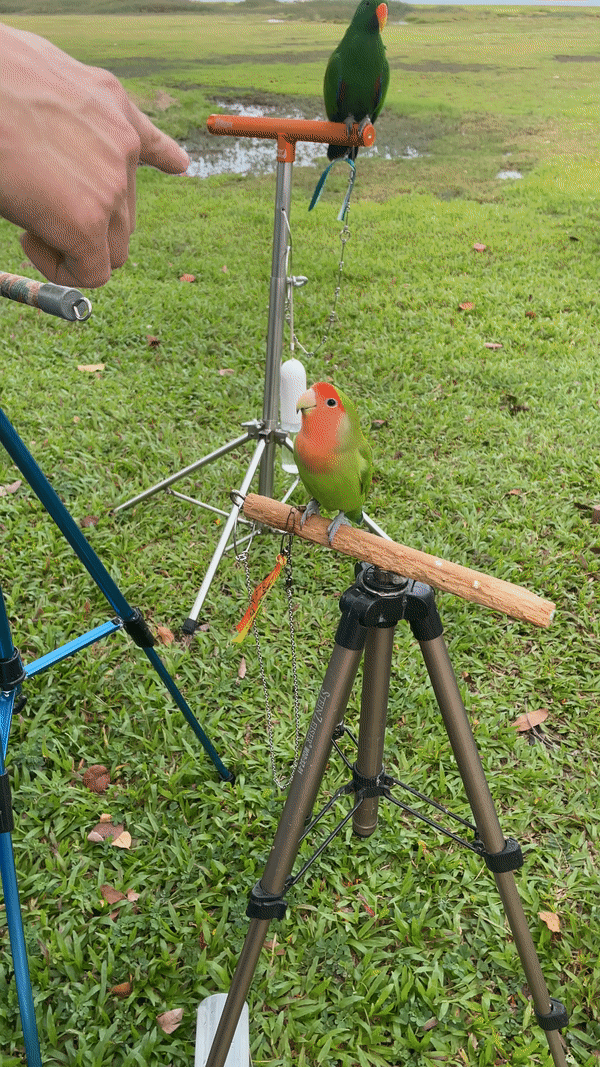 Copper, Mike's Lovebird.
Copper, Mike's Lovebird.
He raises a clenched fist in the air at another of his birds – a ruby Macaw called Royal – the cue for it to perform a trick called “step up”.
Royal raises one leg high into the air, and is duly rewarded.
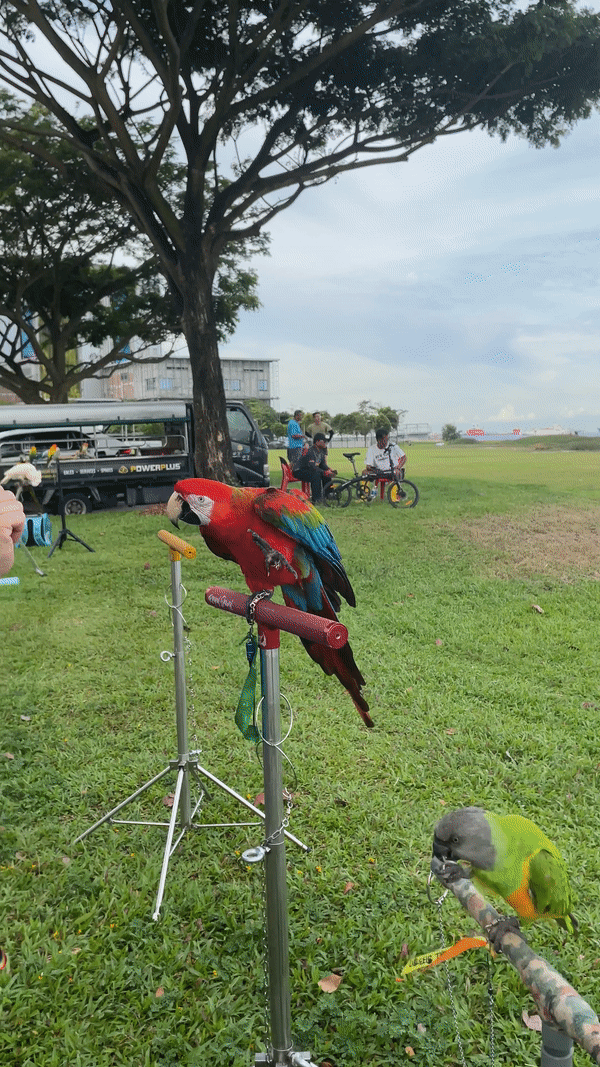 Royal, a ruby Macaw, performs "step up".
Royal, a ruby Macaw, performs "step up".
Another member, Ashley Lim, reflected on how parrot free flying has helped her family grow closer.
The mother of three, whose entire family partakes in the weekly sessions, explained that the family started off with one parrot, Mango.
They later realised that Mango had bonded more closely to her eldest son.
Ashley then stumbled upon the WOPC training sessions on Facebook, and decided to let her son train Mango with Lim, hoping to encourage her son to learn the values of responsibility and commitment, by taking ownership and putting in effort for his pet.
Her son's involvement soon morphed into a family hobby, and the family now heads down unfailingly for the sessions every week together.
While Ashley's children go off and talk to their peers like at any other weekend play date, I noticed them returning to “check-in” with their parrots every so often.
Ashley's daughter Leona, for example, would carefully hold on to her parrot’s blue tag whenever a plane flew past, and when a murder of crows circled the park grounds, Leona and her brothers instinctively shielded their pets and held on to their tags, just to be safe.
Smaller parrots can be literal flight risks as they are easily spooked, and Ashley explained that the children have learnt to be on the look out for possible danger in their immediate environment.
 Leona affectionately petting the family’s parrot, Loofy.
Leona affectionately petting the family’s parrot, Loofy.
 Ashley and her family with their six parrots.
Ashley and her family with their six parrots.
Ashley opined:
“We believe that buying a bird is like fate. The feeling must be mutual, we have learnt that we might choose the bird [initially], but the bird [also] chooses the owner.”
A special relationship
I imagine that Lim would have been proud to hear what Ashley said, as he mentioned something similar during our interview later on — that “the bird chooses the owner, and not the owner chooses the bird”.
It sounds rather cryptic, but Lim explained that it simply means that he believes that each owner should only own one bird when it comes to training for free flight, because that bond formed is sacred, and needs to be nurtured:
“You cannot share. If you share with another person, the bird will tend to look out for the person that loves him more.”
Lim went on to elaborate that training a parrot is much like teaching a child, and requires the gift of trust, while being willing to mete out a certain amount of discipline.
He stated matter-of-factly: “If no discipline, when the parrot flies, the control will break. But if you scold them and don't show them love at all, they’ll [also] hate you forever.”
Lim believes that the parrots understand its owners behaviour and responds to it, and explained that at the end of the day, it is why parrot training – and by extension free flight training – goes beyond whether the parrot is ready, but whether their owner is ready too.
This is especially because parrot training takes time and commitment.
Seeing the fruit of this labour is the biggest reward, and Lim opined that it is what he enjoys the most about the weekly sessions.
“When I see the members fly the birds out and it comes back to them, the smile on their face, that’s something money can’t buy. Their happiness and self satisfaction.”
And after witnessing it for myself, I think I get the appeal – there is something enthralling about watching the parrots themselves flock together out in the concrete jungle, but what is also genuinely winsome is the sight of their owners banding together.
 Some members of the WOPC community during a Saturday session.
Some members of the WOPC community during a Saturday session.
Lim’s end goal is not to have all parrot owners teach their birds to free fly, but rather that the weekly sessions become known as a safe space for new members to learn about the hobby, and for like-minded individuals to cultivate a lasting interest in the activity over time.
“So every weekend I will be here, and when others are free, they can drop by.” Lim added:
“I hope that this hobby, if learned from young, [can teach] kids how to take care of these animals too.”
They say birds of the same feather flock together, and for this bunch, that is a literally apt description.
"For the most part, you can only see parrots flying in Jurong Bird Park," said Lim. "But now we got mini bird park in this location too."
Top images via Mothership
Have something even more interesting going on in your neighbourhood? One-up us at [email protected].
Firsthand is a new content pillar by Mothership, featuring in-depth stories about people and their issues.

If you like what you read, follow us on Facebook, Instagram, Twitter and Telegram to get the latest updates.

